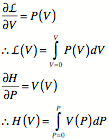Classical Mechanics
11/19/2007
Stanford
class with Leonard Susskind.
Hamiltonian mechanics
Hamiltonian:
· determines the evolution of a system
· phase space states are indicated by points
· trajectories could be closed cycles and multiple cycles
· each cycle represents a conservation law
Cycles in phase space
Cycles don’t run into each other. This can be viewed as information conservation. No phase space points are gained or lost. Example

Hamilton’s Equations
N 2nd order equations imply 2N 1st order equations.
![]() N
equations
N
equations
Define:
![]() then
then
![]()
so 2N first order equations with the variables ![]() . This is a Legendre transformation.
. This is a Legendre transformation.
![]() is a canonical
momentum. Hamilton’s equations describe how a point moves in phase space.
is a canonical
momentum. Hamilton’s equations describe how a point moves in phase space.
Consider V (a velocity) and P (a momentum) which are single valued functions of each other. The graph looks like


![]()
![]() now construct
now construct ![]()
represent a small change as: ![]()

Suppose many V’s. ![]()
![]() now construct
now construct ![]()

How we do mechanics with a Lagrangian.
Repetition, but in the language of Mechanics.
Let ![]()
then
![]()
![]()
![]() from previous
definitions
from previous
definitions
![]()
“q”, the coordinate goes along as a parameter – passive.
![]()
![]()
Since
![]()
then
![]()
Take partials.

Given the Euler-Lagrange equation
![]()
then
![]()
![]()
where
![]()
Velocity is eliminated in favor of position and momentum.
Hamilton’s equations defines modern classical mechanics.
Recapitulate, an 2nd order set of equations can be put into Hamiltonian form.
![]()
Knowing ![]() allows
calculation of velocity in phase space.
allows
calculation of velocity in phase space.
Friction appears only when some coordinates are ignored. Can’t write a system with friction in Hamiltonian form.
Example of Hamiltonian methods.

Check Hamilton’s equations:

Hamilton’s equations establish the relation between velocity and momentum and gives the dynamics of the momentum.
Energy Conservation
Find the total time derivative of the Hamiltonian by using the chain rule.
![]()
Substitute Hamilton’s equations
![]()
The Hamiltonian is constant in time, and so conserved, as long as there is no explicit appearance of time in the Hamiltonian.
A trajectory in phase space stays on a surface o constant energy. The density of points in phase space doesn’t change, so that the phase points behave as an incompressible fluid.
Example: Washboard potential

For large energies the motion is translational. For small energies, it is simple harmonic around a low point.
Assume all quantities are functions of P and q. Calculate the derivative of an arbitrary quantity A(P,q).
![]()
![]()
Define the Poisson bracket.
![]()
Therefore
![]()
Check it.

Similarly

If there is explicit appearance of time then
![]()